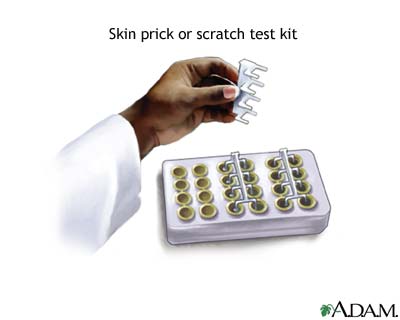

Skin testing is the oldest and most reliable form of allergy testing. This form of testing has been performed for 100 years and continues to be the testing of choice for the diagnosis of allergic disease. Testing begins with a prick, puncture or scratch method, which involves the placing a drop of the allergen in question (usually a commercially available extract of pollens, molds, foods, pet dander, etc) on the skin and abrading the skin with a needle. This testing is not painful, and generally there is no bleeding involved since the needle only scratches the surface of the skin.
After the skin is scratched, the tests takes about 15 minutes to develop. There may be many skin tests performed, depending on the personís age, symptoms and other factors. A positive skin test appears as a raised, red itchy bump, similar to a mosquito bite. The test is compared to the positive and negative controls, which are 2 other skin tests placed along with the allergens to be tested.
The positive control is usually histamine, which will cause a raised, itchy bump in anyone who is not taking an antihistamine medication, such as Benadryl. It is not possible to be allergic to histamine, as this chemical is present in the body. A positive histamine skin test means that any skin tests performed at that same time with a negative result are in fact, truly negative (and that the negative result was not just due to the person taking an antihistamine, for example).
The negative control is usually a salt water, or saline, substance. The purpose of this test is to ensure that a person does not have an irritant effect from the pricking of the needle. A negative skin test result to the negative control ensures that the positive skin test results are not due to an irritant effect from a person with very sensitive skin.
If the prick skin test results are negative to various allergens, but a personís history of allergies suggest that these results should be positive, then another test, called an intradermal skin test, can be performed. Intradermal skin testing, which involves the injection of a diluted allergen extract under the top layer of the skin with a needle, may be able to diagnose more people with allergic disease than with the prick test alone. Unfortunately, intradermal skin tests may cause more false positive results, and these tests cannot be used in testing for food allergies.
A skin test represents allergic disease in miniature. It is a useful tool for people to see (and feel) their positive skin test to cat dander, for example, to truly understand that they are allergic to cats. This educational experience is much more dramatic than handing a person a report of a positive cat allergy test performed using a blood test.
|
|
|
|
|
|
|
|
|